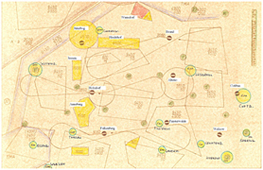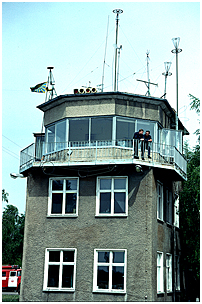
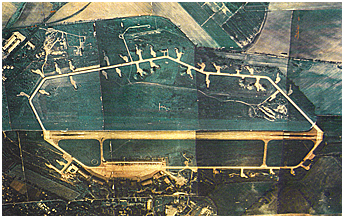 Soviet airbases in G.D.R. were primarily old Luftwaffe airfields that were adapted, enlarged and modernized
according to the aircraft evolution and the operating procedures (hard and longer runways, taxiways, dispersals,
hardened aircraft shelters, nuclear weapons storage areas etc.).
Consequently, the old infrastructures inherited from the nazi Luftwaffe like some
hangars, the control towers or administrative and living quarters were still in place and operational, even if their
general aspect looked often neglected in the eyes of a westerner. There were of course some exceptions like in Tutow,
where most of the buildings, including the control tower were recently built.
Allstedt, Brand, Cochstedt, Gross Dölln, Mahlwinkel and Sperenberg airbases were built after 1945.
Soviet airbases in G.D.R. were primarily old Luftwaffe airfields that were adapted, enlarged and modernized
according to the aircraft evolution and the operating procedures (hard and longer runways, taxiways, dispersals,
hardened aircraft shelters, nuclear weapons storage areas etc.).
Consequently, the old infrastructures inherited from the nazi Luftwaffe like some
hangars, the control towers or administrative and living quarters were still in place and operational, even if their
general aspect looked often neglected in the eyes of a westerner. There were of course some exceptions like in Tutow,
where most of the buildings, including the control tower were recently built.
Allstedt, Brand, Cochstedt, Gross Dölln, Mahlwinkel and Sperenberg airbases were built after 1945.
Numerous airfields, sometimes civilian but most often former military, would have been used in case of
war to disperse the units and avoid their destruction on their homebase. Aviation regiments were deployed regularly to some of
them, like at Reinsdorf, for several days or weeks.
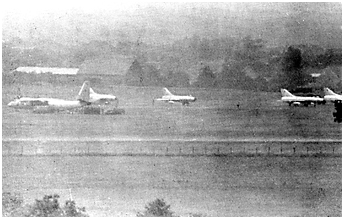 En juillet 1975, 24 Su-7 du 497.IBAP de Grossenhain furent déployés sur
l'aérodrome de réserve situé à Hassleben (ci-contre). La même année, des MiG-21bis du 296.IAP
d'Altenburg opérèrent au départ de Reinsdorf. © USMLM.
En juillet 1975, 24 Su-7 du 497.IBAP de Grossenhain furent déployés sur
l'aérodrome de réserve situé à Hassleben (ci-contre). La même année, des MiG-21bis du 296.IAP
d'Altenburg opérèrent au départ de Reinsdorf. © USMLM.
24 Su-7 of the 497.IBAP from Grossenhain were deployed in July 1975 to Hassleben reserve
airfield (this picture). The same year, MiG-21bis of the 296.IAP from Altenburg were observed at Reinsdorf.
© USMLM.
As most of the Soviet aircraft were able to operate from rudimentary surfaces,
most of the latter airfields had only one large grass runway available.
Long and straight motorway sections would have
been used in wartime to disperse aircraft. Exercises took place more or less regularly on these motorway sections,
sometimes with the participation of LSK/LV aircraft at the same time as 16.VA aircraft.
Nearly 200 landing areas for helicopters were dispersed on the whole East German territory, like on the training grounds,
garrisons, command centers or air defence radar sites (see also the Mi-24 chapter).
Some Army Aviation helicopter bases like Mahlwinkel had long hard runways as they used to be occupied in the past
by jet aircrafts. Others, like Nohra, which had never seen jet activity, were equipped with a short hard surface to
allow the typical rolling take off of the Soviet helicopters.
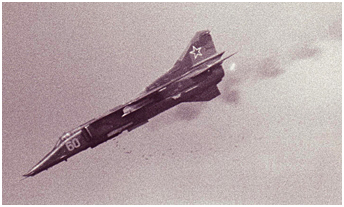 In addition to the Baltic Sea firing ranges (see > Target towing units),
several air-to-ground firing ranges were available for the aircraft and helicopter of the Group of Soviet Forces in
Germany. Unguided rockets, bombs and air-to-surface missiles (1)
were delivered regularly on range targets and gun firing was also practised.
Moreover, aircraft and helicopters of the GSVG overflew the training grounds of the Soviet Army (but not necessarily used
weapons) during big exercises like the "Zapad" (West) maneuvers or on the occasion of specific exercises.
The better known firing range was located near Wittstock (2)
(it was called Gadow-Rossow in the West, from the name of the two nearest villages).
A fake NATO airfield (which looked to some extent like Bitburg AFB in FRG) with a 2.800 meters long runway, taxiways and
dispersal areas had been traced on the soil. Withdrawn from use aircraft probalby from Germany and possibly from Soviet
Union, were standing there as targets. During the last years of activity in Germany, the only aircraft to be seen on this
range were Yak-27s and especially MiG-17s - some of the latter still wearing DOSAAF (3)
paramilitary organisation markings). They were transferred to Rangsdorf for destruction before the troops withdrawal from Germany.
In addition to the Baltic Sea firing ranges (see > Target towing units),
several air-to-ground firing ranges were available for the aircraft and helicopter of the Group of Soviet Forces in
Germany. Unguided rockets, bombs and air-to-surface missiles (1)
were delivered regularly on range targets and gun firing was also practised.
Moreover, aircraft and helicopters of the GSVG overflew the training grounds of the Soviet Army (but not necessarily used
weapons) during big exercises like the "Zapad" (West) maneuvers or on the occasion of specific exercises.
The better known firing range was located near Wittstock (2)
(it was called Gadow-Rossow in the West, from the name of the two nearest villages).
A fake NATO airfield (which looked to some extent like Bitburg AFB in FRG) with a 2.800 meters long runway, taxiways and
dispersal areas had been traced on the soil. Withdrawn from use aircraft probalby from Germany and possibly from Soviet
Union, were standing there as targets. During the last years of activity in Germany, the only aircraft to be seen on this
range were Yak-27s and especially MiG-17s - some of the latter still wearing DOSAAF (3)
paramilitary organisation markings). They were transferred to Rangsdorf for destruction before the troops withdrawal from Germany.
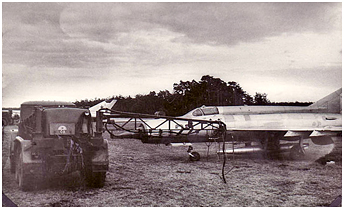 |
 | Airbases |
 | Reserve airfields | |
 | Motorway runways | |
 | Firing ranges | |
 | Firing ranges users |
Go to this page to download three Google Earth files with which you will be able to localize and see the airbases, motorway runways, restricted airspace for exemple above firing ranges and more. Don't be in a hurry and choose carefully your options if you don't want to be submerged by information.
Download a Google Earth file entitled "wittstock_range" showing the location of the various targets and buildings on the Wittstock firing range, together with a superposition of Bitburg airbase, here - file created by Manfred Bischoff.
 |
FIRING RANGES PHOTO PAGE |  |
notes
(1)
Live air-to-surface missile firing campaigns took place generally one time per year for each unit - the western observers noted a
regular use of the ASM from the mid-1980s.
However, only laser or radio guided missiles could be fired in Warsaw Pact countries. The Wittstock range
was certified only for Kh-25L/ML and Kh-29L/T laser and radio guided missiles (Su-17, Su-24, Su-25 and MiG-27) and for
Kh-23/M radio guided missiles (Su-17M3, Su-24 and MiG-27).
In order to shoot ARM missiles, it was necessary to deploy the units to SSSR on dedicated firing ranges like the one
at Telemba near Chita.
(2) It was originally planned that the Wittstock range would be
taken over by the Bundeswehr. The protests of the local population finally led to the withdrawal
of that project during the summer of 2009. Photo report
here.
(3)
Dobrovolnoe Obchtchestvo Sodeistviya Armiy Aviatsiy i Flotou, or
Society of Volunteers for the Cooperation with the Army, the Air Force and the Navy.
 |
Plan du site - Sitemap |  |

